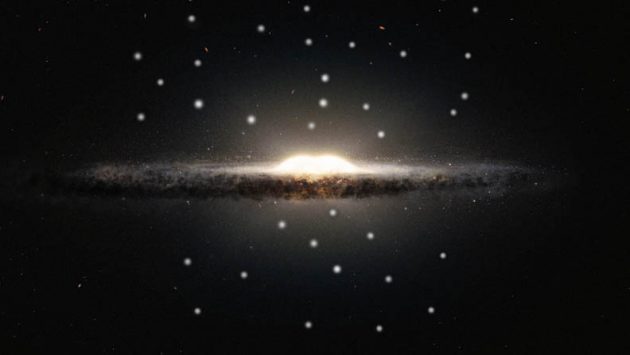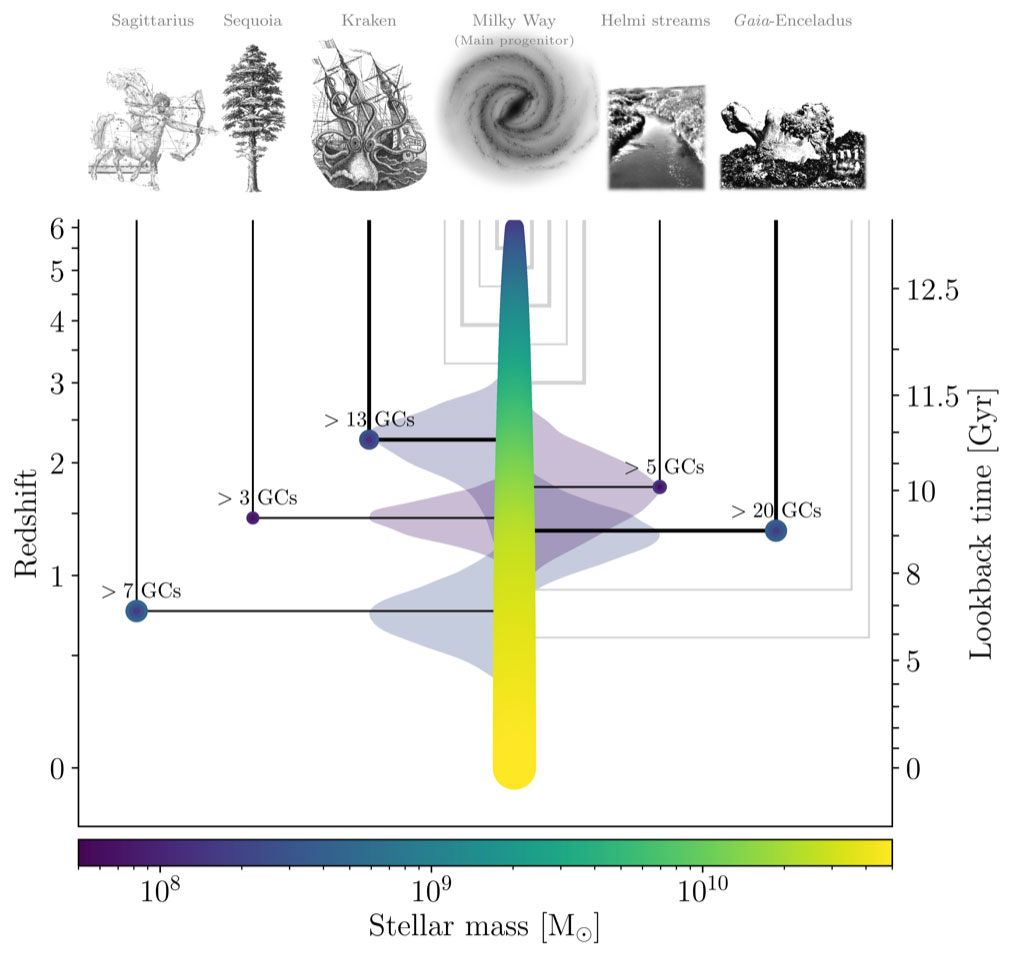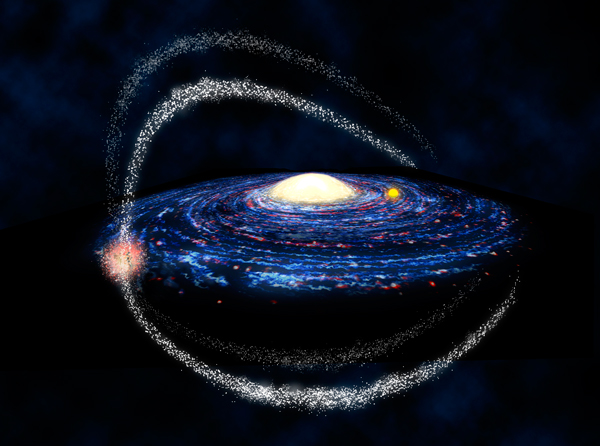Astronomers have reconstructed the Milky Way’s merger history, finding that our galaxy has absorbed five large satellite galaxies in the last 12 billion years.

Our galaxy is old, nearly as old as the universe itself. But it didn’t start as a spiral of stars around a peanut-shape middle. It grew over time, both accumulating stars from collisions with other galaxies and forming stars itself from inflowing gas.
Piecing together the details of this history is a major goal of astronomers, and Diederik Kruijssen (Heidelberg University, Germany, and Harvard) and colleagues have proposed one version of this story, now published in the Monthly Notices of the Royal Astronomical Society (preprint available here).
The Big Five
To peek into the past, Kruijssen and colleagues examined globular clusters. These ancient balls of densely packed stars were pawns of history, accompanying satellite galaxies as they were subsumed into the Milky Way. Now they largely orbit outside our galaxy’s disk in the stellar halo. Astronomers know of at least 150 of them.
Many globular clusters formed right where they are, but the orbits of a subset of them suggest they’re strangers in a strange land. These clusters don’t have as many elements heavier than hydrogen and helium, known to astronomers as metals, indicating their origin in smaller galaxies rather than the larger and metal-enriched Milky Way.
To understand where — and when — these globular clusters came from, Kruijssen’s team relied on a set of zoomed-in cosmological simulations called E-MOSAICS. These simulations show the evolution of Milky Way-like galaxies as they cannibalize smaller galaxies, subsuming their globular clusters.
“Galaxy assembly is an extremely messy process, during which the orbits of the globular clusters are completely reshuffled,” Kruijssen explains. “To make sense of the complex system that is left today, we therefore decided to use artificial intelligence.”
Kruijssen and his colleagues trained an artificial neural network on E-MOSAICS, teaching it to relate the properties of globular clusters and their galaxy of origin. The result is a history of the most significant mergers with other galaxies:

D. Kruijssen et al. / Monthly Notices of the Royal Astronomical Society
- First came a galaxy playfully dubbed “the Kraken,” which collided with our galaxy around 11 billion years ago. Though not the most massive satellite that the Milky Way encountered, it was the most significant with respect to our galaxy’s mass at the time. It contributed at least 13 globular clusters to the Milky Way.
- A billion years later came a smaller galaxy whose remains are seen as a rivulet of stars dubbed the Helmi streams; it brought along at least five globular clusters.
- Another two small galaxies joined our own in quick succession, nicknamed “Sequoia” and “Gaia-Enceladus,” accompanied by at least three and at least 20 globular clusters, respectively.
- The most recent acquisition was the Sagittarius dwarf, which joined us 7 billion years ago. In addition to the seven globular clusters it brought with it, the galaxy’s remains are also visible as strung-out loops of stars circling our galaxy on nearly polar orbits.

Amanda Smith / University of Cambridge
Gaia-Enceladus was previously thought to be the biggest collision. “However, the merger with Kraken took place 11 billion years ago, when the Milky Way was four times less massive,” Kruijssen explains. “As a result, the collision with Kraken must have truly transformed what the Milky Way looked like at the time.”
It’s possible that many other, smaller galactic collisions took place that did not contribute globular clusters, but this study wasn’t designed to catalog those.
Interestingly, Kruijssen and his colleagues also find that although these galaxy collisions represent the most major events of the Milky Way’s history, they only contributed about a billion stars, about the mass of the stellar halo but a drop in the bucket compared to the spiral-imprinted disk. Most of our stars formed within our galaxy.
What Does “Average” Mean, Anyway?
Helmer Koppelman (Institute for Advanced Study, Princeton), who was not involved in the study, calls it “a fascinating summary of the Milky Way’s merger history.”
J. Pfeffer / D. Kruijssen / R. Crain / N. Bastian
But there are some philosophical caveats to keep in mind. First, although the study is based on simulations of galaxies that are on average like the Milky Way, Koppelman explains that “the ‘average’ galaxy might not exist – meaning that each galaxy has its own peculiarities.”
Not only do the simulations assume an “average” Milky Way, they also assume a specific universe. Other simulations — and there are a wide range of them — might give different results. In fact, the study of galaxies’ formation history is inspired in part by the desire to test how well simulated universes reflect reality.
“In a way, the authors have provided an excellent test for this,” Koppelman says. “Independent future research that either agrees or disagrees with the merger history presented in the paper might tell us whether the simulations are accurate or not.”
There’s clearly a lot of work still to be done in reconstructing our galaxy’s messy history, but this study provides a cohesive framework for those efforts.
 0
0









Comments
You must be logged in to post a comment.